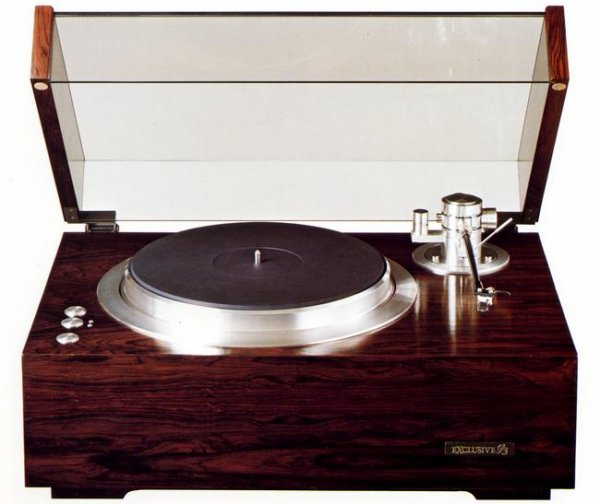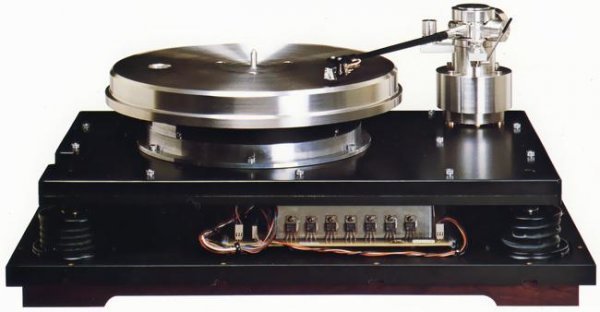First I want to say that I believe that the turntable is as good as Myles says it is...this is not a criticism of his opinion on the product. I am more complaining about the misrepresenation of older Japanese technology and incorrect statements I found in the review.
As for misrepresentation of DD from the past. He basically states that they had not solved the cogging issues but this was clearly not the case with the last generation DD tables from the likes of Kenwood, Yamaha, Nakamichi etc. Sure the first generation SP10 had this issue but by Mk3 it was largely solved. I think people forget that DD was alive and well in Japan right up until cd killed most of them off (early to mid 1980s).
Also misrepresented was the noise of direct drive TTs. The Kenwood L07D had a noise of -94db and the Yamama GT2000 had a noise of -85db! Both are superior to most if not all belt drive TTs and even come close to cd. Only early ones were noisy...
Ringing platters? Given the massiveness of the platters used in top DD TTs from the day (7kg for the Kenwood and 6kg for the Yamaha and both made of solid metal...like the VPI platter) I don't think this was an issue...at least not more than VPI's new platter that was given as a big upgrade over previous VPI platters.
Speed instability? Again, hunting was a problem in the early ones but by the 2nd or 3rd generation that had been solved too and the speed is ultra stable. I have compared a number of TTs now with my Allnic Speednic and the Yamaha GT2000 is the ONLY one that is absolutely rock stable...even pushing on the platter with your finger or with a record playing...not even a hint of speed instability. I have tried TTs like the SME 20/2, Acoustic Solid, Transrotor (huge 3 motor design) and a couple of lower end DD TTs and the Yamaha creams them all for speed stability.
Vast majority? Japan and Germany (EMT?) made many tens of thousands of DD turntables...most so/so but the better ones are still competitive with top models today.
An incorrect statement was that the Goldmund Reference was a direct drive turntable but in fact it was a belt drive turntable. The Goldmund Studio and Studietto were both direct drive (and good ones too) that can be found used for pretty reasonable money.
Anyway, just wanted to clear some of my thoughts on what Myles put in the review that I found misleading of past technology and one factually incorrect statement.
As for misrepresentation of DD from the past. He basically states that they had not solved the cogging issues but this was clearly not the case with the last generation DD tables from the likes of Kenwood, Yamaha, Nakamichi etc. Sure the first generation SP10 had this issue but by Mk3 it was largely solved. I think people forget that DD was alive and well in Japan right up until cd killed most of them off (early to mid 1980s).
Also misrepresented was the noise of direct drive TTs. The Kenwood L07D had a noise of -94db and the Yamama GT2000 had a noise of -85db! Both are superior to most if not all belt drive TTs and even come close to cd. Only early ones were noisy...
Ringing platters? Given the massiveness of the platters used in top DD TTs from the day (7kg for the Kenwood and 6kg for the Yamaha and both made of solid metal...like the VPI platter) I don't think this was an issue...at least not more than VPI's new platter that was given as a big upgrade over previous VPI platters.
Speed instability? Again, hunting was a problem in the early ones but by the 2nd or 3rd generation that had been solved too and the speed is ultra stable. I have compared a number of TTs now with my Allnic Speednic and the Yamaha GT2000 is the ONLY one that is absolutely rock stable...even pushing on the platter with your finger or with a record playing...not even a hint of speed instability. I have tried TTs like the SME 20/2, Acoustic Solid, Transrotor (huge 3 motor design) and a couple of lower end DD TTs and the Yamaha creams them all for speed stability.
Vast majority? Japan and Germany (EMT?) made many tens of thousands of DD turntables...most so/so but the better ones are still competitive with top models today.
An incorrect statement was that the Goldmund Reference was a direct drive turntable but in fact it was a belt drive turntable. The Goldmund Studio and Studietto were both direct drive (and good ones too) that can be found used for pretty reasonable money.
Anyway, just wanted to clear some of my thoughts on what Myles put in the review that I found misleading of past technology and one factually incorrect statement.






